Very impressive, Stuglo, a pleasure to watch.
-

Win a Free Custom Engraved Brass Coin!!!
As a way to introduce our brass coins to the community, we will raffle off a free coin during the month of August. Follow link ABOVE for instructions for entering.
You are using an out of date browser. It may not display this or other websites correctly.
You should upgrade or use an alternative browser.
You should upgrade or use an alternative browser.
- Joined
- Apr 20, 2020
- Messages
- 6,180
- Points
- 738

great progress, excellent workLower Deck Beams (cont.)
Their positions do not match exactly the stations on the plan and must be taken from the NMM plans.
After measuring and comparison to the framing plan, these can be marked. After several hours, I checked out Kevin’s video blog, and saw a central strake,marked directly from the NMM plan, and overlying the beams, allowing a more accurate positioning.
Recommended to start with beams #11 and #12( overling the well)
A simple measuring device is described in TFFM which I have simplified further ( fabric wire rapper and stick broken in half)
Remembering the “let down”- I milled 0.53mm notches either end of the beam once it had been cut to size and fixed (temporarily) with rubber cement.
Height then checked with the depth gauge.
Beams fore of the similarly made, with attention to shaping ends to match the curve of the clamp.
The beams aft of #13 supposedly to rather than on the clamp (like platform beams) but #14 and #15 managed with a deeper notch.View attachment 242876View attachment 242877


SUPPORT PILLARS for Lower deck beams
Details from TFFM and profile plan Atalanta
Most centred under beam and note relationship to structures of platforms and bulwarks. The position of a few beams slightly altered.
Also allowance for slope of keelson upon which the pillars stand.
**One of the advantages in writing this blog is that although the rough copy is produced while working on the model, this published version is after completing each stage. Therefore, although I note that the pillars are generally 3.2mm square, nos. 11 and 12 are 2.65mm sq. THIS I FORGOT. So removal and alteration required.**
Tenons are mentioned at bases, treenails given as an alternative. I used brass pins , removing the head, and CA glue.
Using a small version of the measuring device, heights measured, appropriate shapins of base into which the pin inserted into a predrilled hole.
The corners, except those abutting bulworks, are chamfered from 4.24mm above base to 3.20mm below beam. A simple jig helped this.
The 5 pillars fore and 5aft have a tapered chamfer.
Pillars 19+20 are extra long and will be left ‘til later.
Note also that no pillars are shown beneath beams #1 and #5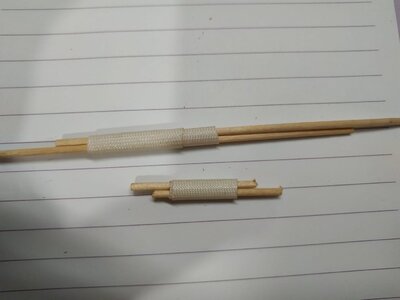
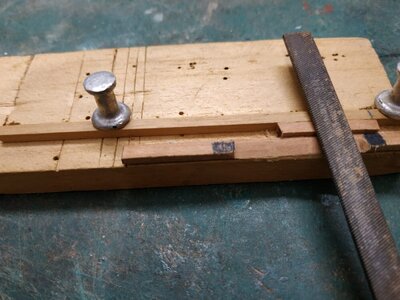
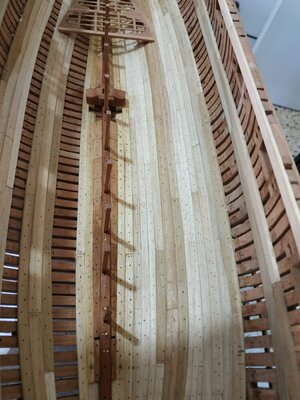
Details from TFFM and profile plan Atalanta
Most centred under beam and note relationship to structures of platforms and bulwarks. The position of a few beams slightly altered.
Also allowance for slope of keelson upon which the pillars stand.
**One of the advantages in writing this blog is that although the rough copy is produced while working on the model, this published version is after completing each stage. Therefore, although I note that the pillars are generally 3.2mm square, nos. 11 and 12 are 2.65mm sq. THIS I FORGOT. So removal and alteration required.**
Tenons are mentioned at bases, treenails given as an alternative. I used brass pins , removing the head, and CA glue.
Using a small version of the measuring device, heights measured, appropriate shapins of base into which the pin inserted into a predrilled hole.
The corners, except those abutting bulworks, are chamfered from 4.24mm above base to 3.20mm below beam. A simple jig helped this.
The 5 pillars fore and 5aft have a tapered chamfer.
Pillars 19+20 are extra long and will be left ‘til later.
Note also that no pillars are shown beneath beams #1 and #5



Fantastic work Stuglo
Excellent work! Beautiful, Stuglo!
Yes absolutely right. Beautiful, precise and clean work. Fun to follow.Excellent work! Beautiful, Stuglo!
Fishroom Bulkhead
Fits under forebeam of aft platform, HORIZONTAL planks 1mmX4.77wide.
Made a paper plan, simply by trial and error ie. snip and fit. (my pin shape is too wide)
The bulkhead is braced by a pair of stanchions 2.12 mm sq.
To be fitted after the platform is finished and in place
Aft Platform Planking.
TFFM calls for planks 0.8mm thick and 6.36 wide. I have some walnut left over from kit at 5mm wide, so I decided to go with this.Hope this is not too unorthodox.
The planking leaves a scuttle edge free at 1mm to allow for a rebated hatch.
It also falls short on the fore beam to allow a lip-shaped lip extending over the beam for most of its length. This edge is rounded.
I marked and cut out holes for the pillars.
A half (port) lid was made with similar planking.A hole is also required in this for a pillar.
Hinges also left over from another kit.
Decided against fastenings (this time not treenails) as probably almost invisible.
Fitted, glued and bulkhead added when set,
Finished with tung oil.
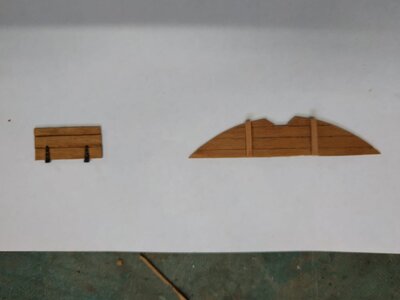
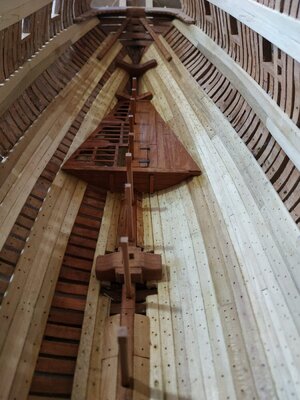
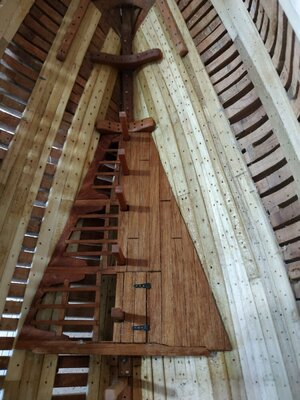
Fits under forebeam of aft platform, HORIZONTAL planks 1mmX4.77wide.
Made a paper plan, simply by trial and error ie. snip and fit. (my pin shape is too wide)
The bulkhead is braced by a pair of stanchions 2.12 mm sq.
To be fitted after the platform is finished and in place
Aft Platform Planking.
TFFM calls for planks 0.8mm thick and 6.36 wide. I have some walnut left over from kit at 5mm wide, so I decided to go with this.Hope this is not too unorthodox.
The planking leaves a scuttle edge free at 1mm to allow for a rebated hatch.
It also falls short on the fore beam to allow a lip-shaped lip extending over the beam for most of its length. This edge is rounded.
I marked and cut out holes for the pillars.
A half (port) lid was made with similar planking.A hole is also required in this for a pillar.
Hinges also left over from another kit.
Decided against fastenings (this time not treenails) as probably almost invisible.
Fitted, glued and bulkhead added when set,
Finished with tung oil.



Get the feeling you really enjoying the build looks great
- Joined
- Apr 20, 2020
- Messages
- 6,180
- Points
- 738

it's looks wonderful, well done my dear friendFishroom Bulkhead
Fits under forebeam of aft platform, HORIZONTAL planks 1mmX4.77wide.
Made a paper plan, simply by trial and error ie. snip and fit. (my pin shape is too wide)
The bulkhead is braced by a pair of stanchions 2.12 mm sq.
To be fitted after the platform is finished and in place
Aft Platform Planking.
TFFM calls for planks 0.8mm thick and 6.36 wide. I have some walnut left over from kit at 5mm wide, so I decided to go with this.Hope this is not too unorthodox.
The planking leaves a scuttle edge free at 1mm to allow for a rebated hatch.
It also falls short on the fore beam to allow a lip-shaped lip extending over the beam for most of its length. This edge is rounded.
I marked and cut out holes for the pillars.
A half (port) lid was made with similar planking.A hole is also required in this for a pillar.
Hinges also left over from another kit.
Decided against fastenings (this time not treenails) as probably almost invisible.
Fitted, glued and bulkhead added when set,
Finished with tung oil.
View attachment 243598View attachment 243599View attachment 243600


Its so fantastic….. I have no Words
THE WELL and SHOT LOCKERS.
These are compartments in the hold.
Dimensions given are 35mm sq for the former, and the latter, same width and 11.13mm long.
The rear bulkhead sits under the aft aspect of beam#12 . The height is that of the underside or the lower deck beam.
The fore bulkhead of the locker is 24mm, the sides continuous with the well, slope down from the bulkhead shared with the well.
At the bulkhead corners are stanchions, 3.18mm sq. The pillars #11 and #12 between them on their respective bulkheads. Foremost, are stanchions at the corners of the locker that have a 45deg bevel.
Additionally there is a similarly sized cross beam marking the height of the locker.
**I think the main problem is deciding the order of build. **
As the pillars already in place determine the position and dimensions, I decided to build the bulkheads first. Also the bulkhead can be easily held in position while measuring and making the walls.
Therefore paper templates made, overlaid with the planks (I again used some ready made if undersized wood-only 4.55x1mm)
Stanchions glued to aft side and temporarily clamped to pillar #12.
(Gratifying to see bulkhead match the gap in the limber boards)
The middle bulkhead was similarly made, but as the horizontal beam needed mortising into all 3 stanchions i.e.including the pillar#11, I freed up the latter from its holding pin in the keelson, and milled the required motises.
This proved very useful, as I could now replace and firmly fit the parts as the build required.
With these bulkheads implace, I planked the sides with forward extensions for the locker.
When dried, removed as whole, heights of sides corrected, and using the cross beam as a guide, shaped the locker side and fore bulkhead.
Inside the locker is a dividing wall, running starboard side of pillar#11 and the fore bulkhead, where a suitably short stanchion adds support.
A pair of lids fit either side of a piece of planking which covers the aforementioned locker partition. Similar planks cover the tops of the walls, rather like bannisters.
A very satisfying build, particularly the order saved a lot of fiddling about. Choice of wood for planks was probably a mistake, but will be mostly hidden from view.
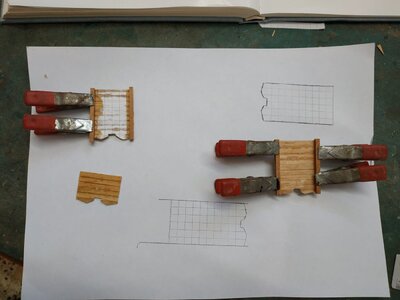
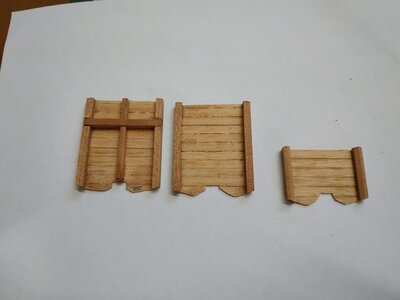
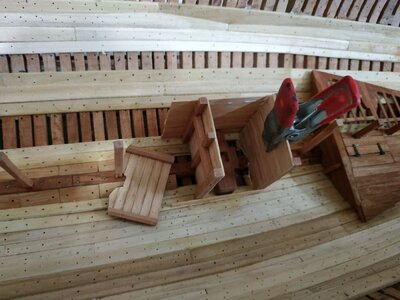
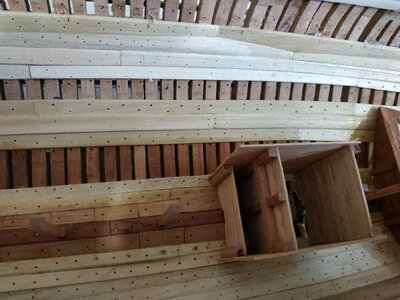
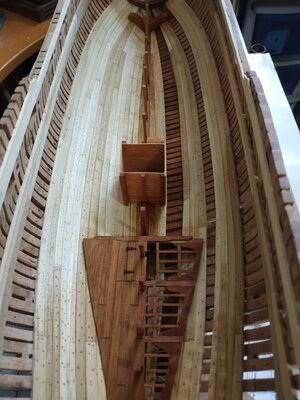
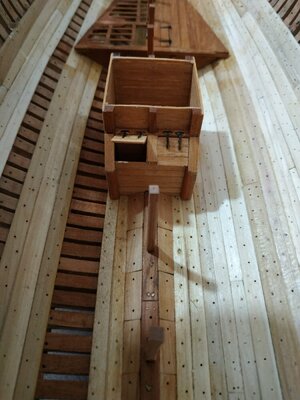
These are compartments in the hold.
Dimensions given are 35mm sq for the former, and the latter, same width and 11.13mm long.
The rear bulkhead sits under the aft aspect of beam#12 . The height is that of the underside or the lower deck beam.
The fore bulkhead of the locker is 24mm, the sides continuous with the well, slope down from the bulkhead shared with the well.
At the bulkhead corners are stanchions, 3.18mm sq. The pillars #11 and #12 between them on their respective bulkheads. Foremost, are stanchions at the corners of the locker that have a 45deg bevel.
Additionally there is a similarly sized cross beam marking the height of the locker.
**I think the main problem is deciding the order of build. **
As the pillars already in place determine the position and dimensions, I decided to build the bulkheads first. Also the bulkhead can be easily held in position while measuring and making the walls.
Therefore paper templates made, overlaid with the planks (I again used some ready made if undersized wood-only 4.55x1mm)
Stanchions glued to aft side and temporarily clamped to pillar #12.
(Gratifying to see bulkhead match the gap in the limber boards)
The middle bulkhead was similarly made, but as the horizontal beam needed mortising into all 3 stanchions i.e.including the pillar#11, I freed up the latter from its holding pin in the keelson, and milled the required motises.
This proved very useful, as I could now replace and firmly fit the parts as the build required.
With these bulkheads implace, I planked the sides with forward extensions for the locker.
When dried, removed as whole, heights of sides corrected, and using the cross beam as a guide, shaped the locker side and fore bulkhead.
Inside the locker is a dividing wall, running starboard side of pillar#11 and the fore bulkhead, where a suitably short stanchion adds support.
A pair of lids fit either side of a piece of planking which covers the aforementioned locker partition. Similar planks cover the tops of the walls, rather like bannisters.
A very satisfying build, particularly the order saved a lot of fiddling about. Choice of wood for planks was probably a mistake, but will be mostly hidden from view.






FORE PLATFORMS
Built in 4 sections.
Referring to the Atalanta profile plan, some variance to TFFM.The bulkheads seem to ve (vertically)continuous and limit the planking.
Somehow, more confusing than their aft counterparts- the importance of previously fitting the lower deck pillars (as suggested by FTTM) becomes obvious.
The aftmost (4th) and 2nd platforms sit about 6.36mm higher than the 3rd.
Locating the aftmost beam 28.5mm aft of 4th pillar (allowing 1mm bulkhead). This aftermost beam mortises into the Bitt uprights.
The cross beams are 3.64x2.65, carlings and ledges also as before(3.16x1.6,1.6x1.0)
As usual, paper copy with mirror image, glue to blank, cut out and shape.
Recessed for pillars 4+5
The higher parts are angled slightly upwards going foreward.
The lowest section appears horizontal about 2.5mm above keelson.
The 2nd section is a narrow part, slightly wider than its beam. The profile plan shows some connection with the first part, but I can't see how with the height of the foremast step.
The foremost section is the same height as the 2nd,it extends under the breast hook.
PLANKING
Extends aft of 4th, to include the Bitt upright and abutts to bulkhead.
Sited as such, the gap in the limberboards is incorrect and needs moving forward by 5mm. (PVA dissolved and boards recut and moved). As TFFM says, go with the plan you have!!
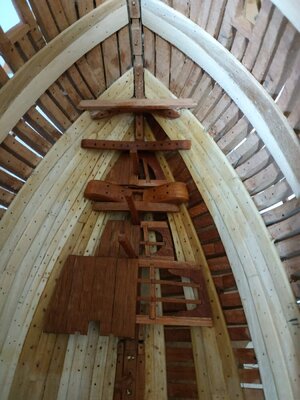
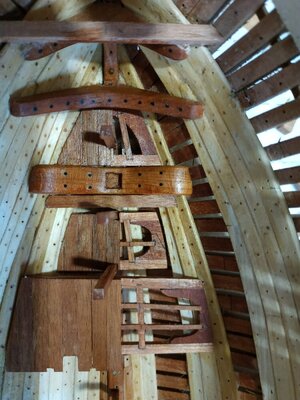
Built in 4 sections.
Referring to the Atalanta profile plan, some variance to TFFM.The bulkheads seem to ve (vertically)continuous and limit the planking.
Somehow, more confusing than their aft counterparts- the importance of previously fitting the lower deck pillars (as suggested by FTTM) becomes obvious.
The aftmost (4th) and 2nd platforms sit about 6.36mm higher than the 3rd.
Locating the aftmost beam 28.5mm aft of 4th pillar (allowing 1mm bulkhead). This aftermost beam mortises into the Bitt uprights.
The cross beams are 3.64x2.65, carlings and ledges also as before(3.16x1.6,1.6x1.0)
As usual, paper copy with mirror image, glue to blank, cut out and shape.
Recessed for pillars 4+5
The higher parts are angled slightly upwards going foreward.
The lowest section appears horizontal about 2.5mm above keelson.
The 2nd section is a narrow part, slightly wider than its beam. The profile plan shows some connection with the first part, but I can't see how with the height of the foremast step.
The foremost section is the same height as the 2nd,it extends under the breast hook.
PLANKING
Extends aft of 4th, to include the Bitt upright and abutts to bulkhead.
Sited as such, the gap in the limberboards is incorrect and needs moving forward by 5mm. (PVA dissolved and boards recut and moved). As TFFM says, go with the plan you have!!


Hallo Stuglo, I‘m really impressed with how beautiful this is going to be. Clean and perfectly worked.
Decision: Despite not visible, will attempt the various rooms and structures in the hold.
Magazine and Filling room.
A series of bulkheads, passages and doors form this and other rooms.
I have no separate plan for this so will go with the patterns in TFFM. Also Dan Vardas’ blog considerably helps understanding.
The stanchions are 2.12mm square. ( The bulkhead planks join to hold ceilings via battens 2.12x1.06mm-which I have omitted. )
Starting with the aftermost bulkhead.
It sits under #19 lower deck beam. The beam pillar, unlike those foreward, extends to support the upper deck beam. The lower deck beam is slightly mortised into this.
The bulkhead does not extend all across to port side, rathervis “squared off”
A pattern is made for the lower edge (trial and error) and the horizontal planks glued to this and the shaped, ensuring the upper edge fits under the beam.
This is glued to the fore side of the pillar #19. They can be removed together as the pillar is attached by a brass pin into the keelson.
The stanchions are added per plan.
The walls are extra thick, as the spaces between the stanchions are filled by mortar.
I represented this by some vertical lime strips 1.38mm thick.
( I decided before the build that I did not want to use paint if possible)
The bulwark can be fitted by positioning the pillar on the pin.
Mizzen mast Sleeve
Tried by “prefabing” walls. Plan does not show an aft wall, but I put one in for stability. Corners chamfered.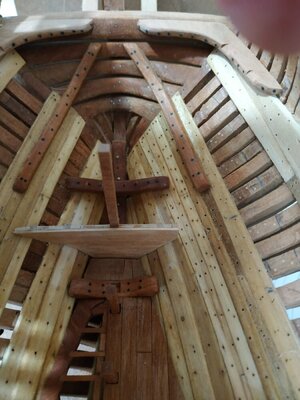
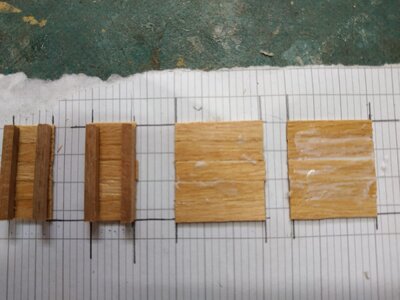
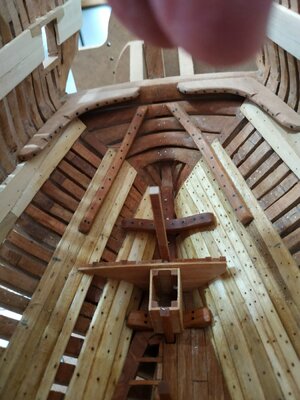
Magazine and Filling room.
A series of bulkheads, passages and doors form this and other rooms.
I have no separate plan for this so will go with the patterns in TFFM. Also Dan Vardas’ blog considerably helps understanding.
The stanchions are 2.12mm square. ( The bulkhead planks join to hold ceilings via battens 2.12x1.06mm-which I have omitted. )
Starting with the aftermost bulkhead.
It sits under #19 lower deck beam. The beam pillar, unlike those foreward, extends to support the upper deck beam. The lower deck beam is slightly mortised into this.
The bulkhead does not extend all across to port side, rathervis “squared off”
A pattern is made for the lower edge (trial and error) and the horizontal planks glued to this and the shaped, ensuring the upper edge fits under the beam.
This is glued to the fore side of the pillar #19. They can be removed together as the pillar is attached by a brass pin into the keelson.
The stanchions are added per plan.
The walls are extra thick, as the spaces between the stanchions are filled by mortar.
I represented this by some vertical lime strips 1.38mm thick.
( I decided before the build that I did not want to use paint if possible)
The bulwark can be fitted by positioning the pillar on the pin.
Mizzen mast Sleeve
Tried by “prefabing” walls. Plan does not show an aft wall, but I put one in for stability. Corners chamfered.



Magazine - fore bulkhead.
(Somewhat complicated. Difficulty in understanding plan/plans as only part is shown on each. This is probably my deficiency, but again I used Vardas’s blogg for a clear picture.)
This bulkhead is “anchored” to pillar #16 and due to its several components, separated the work into starboard and port sides.
The starboard side is only partially “filled” with simulated mortar.
The port side is very interesting. It includes a thick door (opening inwards) with a 3.7mm sill, a V-shaped window projecting into the magazine from the LIGHT room, and a horizontal door opening into the neighbouring bread room.
This part of the bulkhead is made just with the planks and stanchions as shown.
Leaving the sill, a doorway is made for entry to the magazine.The door, thickened, is hinged to the #16 pillar and the other doorpost is a stanchion.I think the sill would also be thick.
Suggestion how to make a window in a TFFM appendix. The windows are only 11x6mm so I tried at first with some copper scraps. Not successful. (Little pieces and fat fingers!)
Next some 1mm square boxwood-pva didn't “grab”
Similar wood, now filled with a drop of epoxy and when dry, milled groove and fitted horizontal munion. Fair result.
A V Shaped base was made and the windows glued to this with a batten covering the vertical join. A similar “roof” attached. Below the base is a 1mm wide wooden bracket.
A corresponding gap, 5mm wide, is made in the bulkhead.
A further hole is cut to fit a “horizontal” door to the bread room.
Copper hinges and handle left as this was used in reality.
The window is attached and a corresponding shelf forward into the passage (not yet built).
The bread room door has a Z-shaped frame and is fitted to open forward.
The thick magazine door is fitted and the port side bulkhead assembly attached so that the sill abutts to the #16 pillar , continuing the line of the starboard side.
The portside magazine wall needs adjusting and perhaps would have better be made now rather than earlier. Some additions (cheating) to its base is necessary, as when realigned to its proper place on the bulkhead, its height needs increasing.
A complicated and fiddly build, but ultimately satisfying and worthwhile even though it will be hidden.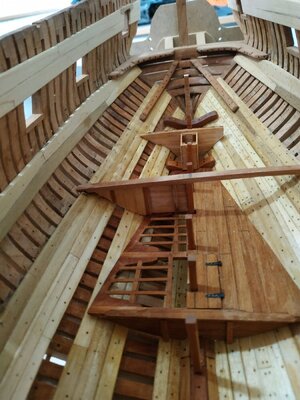
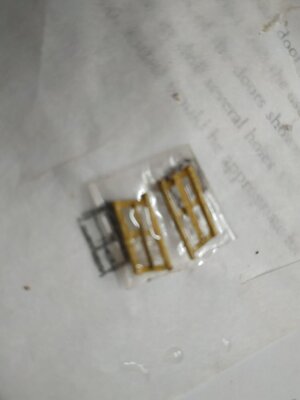
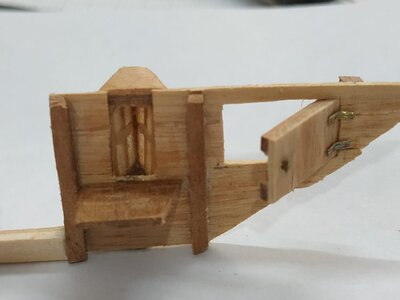
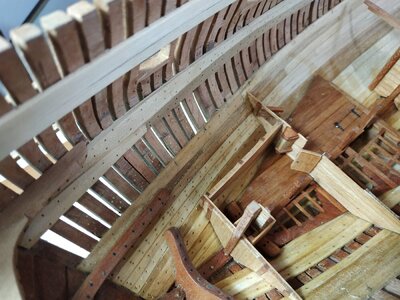
(Somewhat complicated. Difficulty in understanding plan/plans as only part is shown on each. This is probably my deficiency, but again I used Vardas’s blogg for a clear picture.)
This bulkhead is “anchored” to pillar #16 and due to its several components, separated the work into starboard and port sides.
The starboard side is only partially “filled” with simulated mortar.
The port side is very interesting. It includes a thick door (opening inwards) with a 3.7mm sill, a V-shaped window projecting into the magazine from the LIGHT room, and a horizontal door opening into the neighbouring bread room.
This part of the bulkhead is made just with the planks and stanchions as shown.
Leaving the sill, a doorway is made for entry to the magazine.The door, thickened, is hinged to the #16 pillar and the other doorpost is a stanchion.I think the sill would also be thick.
Suggestion how to make a window in a TFFM appendix. The windows are only 11x6mm so I tried at first with some copper scraps. Not successful. (Little pieces and fat fingers!)
Next some 1mm square boxwood-pva didn't “grab”
Similar wood, now filled with a drop of epoxy and when dry, milled groove and fitted horizontal munion. Fair result.
A V Shaped base was made and the windows glued to this with a batten covering the vertical join. A similar “roof” attached. Below the base is a 1mm wide wooden bracket.
A corresponding gap, 5mm wide, is made in the bulkhead.
A further hole is cut to fit a “horizontal” door to the bread room.
Copper hinges and handle left as this was used in reality.
The window is attached and a corresponding shelf forward into the passage (not yet built).
The bread room door has a Z-shaped frame and is fitted to open forward.
The thick magazine door is fitted and the port side bulkhead assembly attached so that the sill abutts to the #16 pillar , continuing the line of the starboard side.
The portside magazine wall needs adjusting and perhaps would have better be made now rather than earlier. Some additions (cheating) to its base is necessary, as when realigned to its proper place on the bulkhead, its height needs increasing.
A complicated and fiddly build, but ultimately satisfying and worthwhile even though it will be hidden.




- Joined
- Apr 20, 2020
- Messages
- 6,180
- Points
- 738

Dear stugloMagazine - fore bulkhead.
(Somewhat complicated. Difficulty in understanding plan/plans as only part is shown on each. This is probably my deficiency, but again I used Vardas’s blogg for a clear picture.)
This bulkhead is “anchored” to pillar #16 and due to its several components, separated the work into starboard and port sides.
The starboard side is only partially “filled” with simulated mortar.
The port side is very interesting. It includes a thick door (opening inwards) with a 3.7mm sill, a V-shaped window projecting into the magazine from the LIGHT room, and a horizontal door opening into the neighbouring bread room.
This part of the bulkhead is made just with the planks and stanchions as shown.
Leaving the sill, a doorway is made for entry to the magazine.The door, thickened, is hinged to the #16 pillar and the other doorpost is a stanchion.I think the sill would also be thick.
Suggestion how to make a window in a TFFM appendix. The windows are only 11x6mm so I tried at first with some copper scraps. Not successful. (Little pieces and fat fingers!)
Next some 1mm square boxwood-pva didn't “grab”
Similar wood, now filled with a drop of epoxy and when dry, milled groove and fitted horizontal munion. Fair result.
A V Shaped base was made and the windows glued to this with a batten covering the vertical join. A similar “roof” attached. Below the base is a 1mm wide wooden bracket.
A corresponding gap, 5mm wide, is made in the bulkhead.
A further hole is cut to fit a “horizontal” door to the bread room.
Copper hinges and handle left as this was used in reality.
The window is attached and a corresponding shelf forward into the passage (not yet built).
The bread room door has a Z-shaped frame and is fitted to open forward.
The thick magazine door is fitted and the port side bulkhead assembly attached so that the sill abutts to the #16 pillar , continuing the line of the starboard side.
The portside magazine wall needs adjusting and perhaps would have better be made now rather than earlier. Some additions (cheating) to its base is necessary, as when realigned to its proper place on the bulkhead, its height needs increasing.
A complicated and fiddly build, but ultimately satisfying and worthwhile even though it will be hidden.View attachment 246859View attachment 246860View attachment 246861View attachment 246862
great progress , it's looks very beautiful


Last edited:
Looking great.
Passageway To Magazine Door
Plank walls with stanchions. (no thick walls) Forms a dog leg.
Height determined by underside of beam, and width according to plan in TFFM.
Door sill again 3.71mm and I made a Zframe for a thicker door .
Door and Light Room.
Not all walls are parallel.I fitted doorways with lintels when not directly under beams.
The shelf in light room needed removing to alter shape slightly to fit the angle of the wall.
Door: narrow with vertical planking
Stewards Room: foreward to bedroom on port side.
Ensure height suitable for #15 beam (19.5mm at center)
The Steward room door is relatively wide (15mm) and is split horizontally. It has 2 sets of L-shaped hinges.
Forward of this is a narrow slops room with a simple door.
These doors, we are told, can be made with a barred opening or simple holes. The former is too much at this scale and with cause me excessive frustration for what will be a hidden piece
The Starboard rooms (Marines and Captains storerooms) apparently mirror the Steward’s and Slops rooms of the port side. These will be omitted.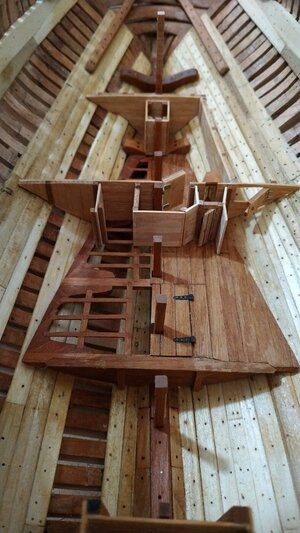
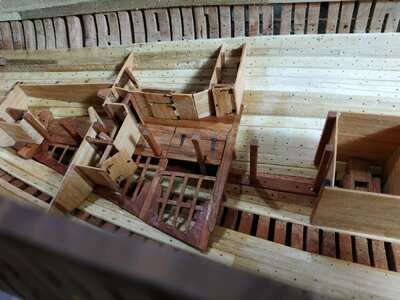
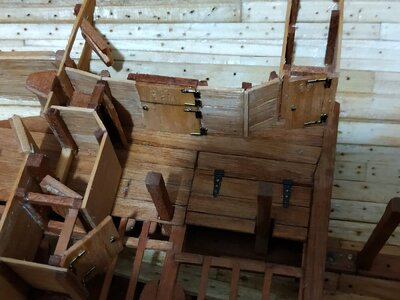
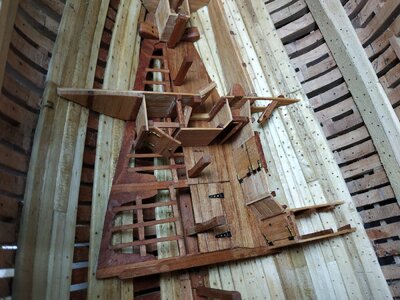
Plank walls with stanchions. (no thick walls) Forms a dog leg.
Height determined by underside of beam, and width according to plan in TFFM.
Door sill again 3.71mm and I made a Zframe for a thicker door .
Door and Light Room.
Not all walls are parallel.I fitted doorways with lintels when not directly under beams.
The shelf in light room needed removing to alter shape slightly to fit the angle of the wall.
Door: narrow with vertical planking
Stewards Room: foreward to bedroom on port side.
Ensure height suitable for #15 beam (19.5mm at center)
The Steward room door is relatively wide (15mm) and is split horizontally. It has 2 sets of L-shaped hinges.
Forward of this is a narrow slops room with a simple door.
These doors, we are told, can be made with a barred opening or simple holes. The former is too much at this scale and with cause me excessive frustration for what will be a hidden piece
The Starboard rooms (Marines and Captains storerooms) apparently mirror the Steward’s and Slops rooms of the port side. These will be omitted.








